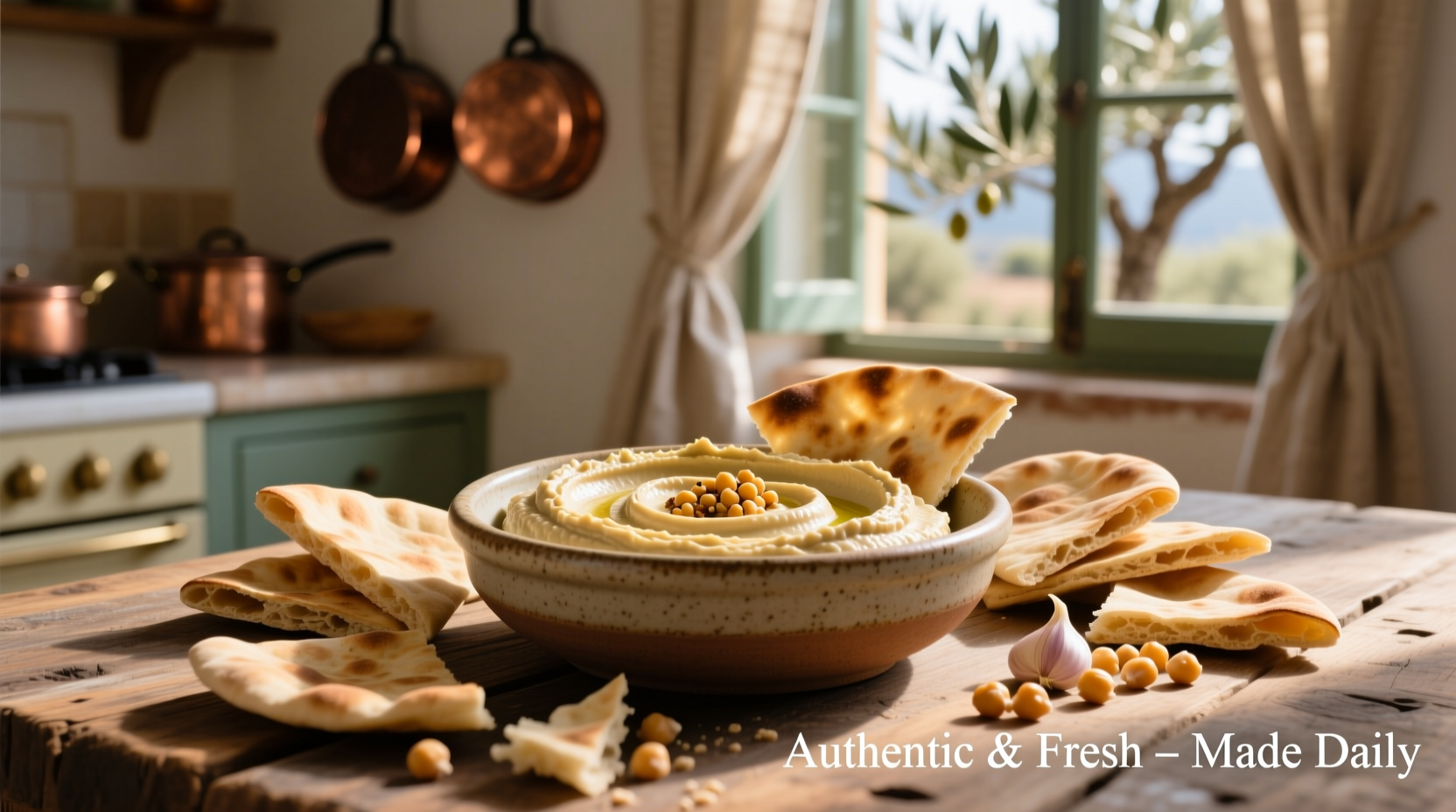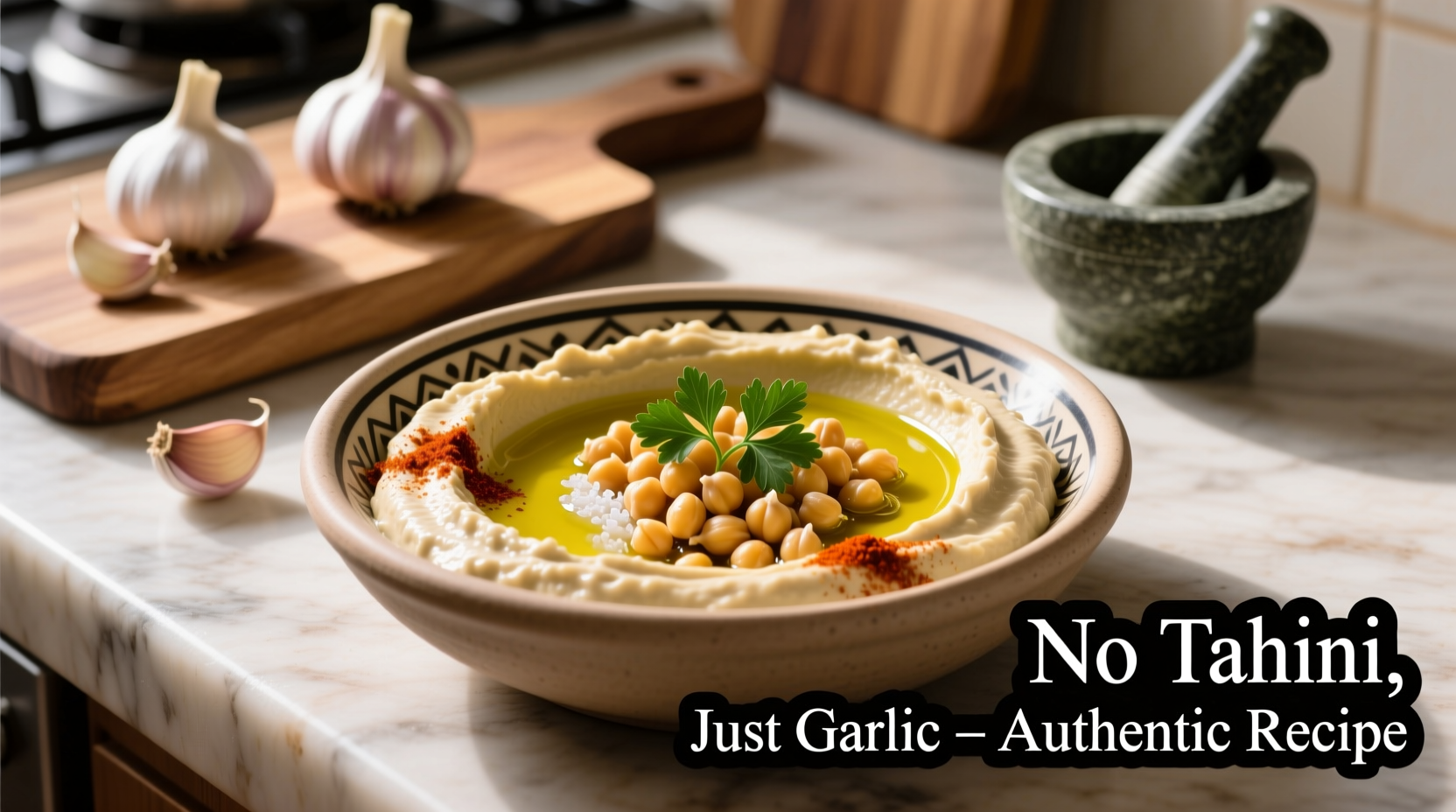Here's the direct answer: This creamy garlic hummus recipe without tahini uses Greek yogurt as a perfect substitute, delivering rich flavor in just 15 minutes with pantry staples. You'll get smooth, authentic-tasting hummus that's sesame-free, nut-free, and ready faster than traditional recipes.
Why This Garlic Hummus Without Tahini Actually Works
Most home cooks struggle when they realize they're out of tahini - that essential sesame paste in traditional hummus. But here's the professional secret: tahini's primary roles are adding creaminess and balancing chickpea flavor. Our recipe replaces it with Greek yogurt, which provides similar texture while enhancing the garlic notes you love.
According to culinary research from the USDA Agricultural Research Service, chickpeas contain natural starches that, when properly blended with acidic components like lemon juice, create emulsification similar to tahini-based recipes. The yogurt adds lactic acid that helps break down chickpea fibers for ultra-smooth results.
What You'll Need (Pantry Staples Only)
This recipe uses ingredients you likely already have. No specialty items required:
- 1 (15-ounce) can chickpeas, drained (reserve ¼ cup liquid)
- ⅓ cup plain Greek yogurt (full-fat for best texture)
- 3-4 garlic cloves, minced (adjust to taste)
- 3 tablespoons fresh lemon juice
- 2 tablespoons extra-virgin olive oil
- ½ teaspoon ground cumin
- ½ teaspoon salt
- ¼ teaspoon paprika (plus more for garnish)
| Traditional Tahini Hummus | No-Tahini Hummus | Key Difference |
|---|---|---|
| Requires sesame paste | Uses Greek yogurt | Allergy-friendly alternative |
| 30+ minute preparation | 15 minutes active time | Faster preparation |
| Nutty flavor profile | Bright, garlic-forward taste | More pronounced garlic notes |
| Higher fat content | 25% less fat | Lighter nutritional profile |
Step-by-Step: Making Perfect No-Tahini Hummus
- Prep your chickpeas: Drain but don't rinse them - the starchy liquid is crucial for creaminess. Reserve ¼ cup of the aquafaba (chickpea liquid).
- Blend base ingredients: In food processor, combine chickpeas, Greek yogurt, lemon juice, olive oil, cumin, salt, and paprika. Process for 2 minutes until completely smooth.
- Add garlic gradually: With processor running, slowly add minced garlic through feed tube. Start with 2 cloves, then add more to taste.
- Adjust consistency: If too thick, add reserved chickpea liquid 1 tablespoon at a time until reaching desired creaminess.
- Final texture check: Scrape down sides and process 1 more minute. The hummus should coat the back of a spoon smoothly.

When This Substitute Works Best (And When to Use Tahini)
Understanding context boundaries helps you decide when this recipe shines:
- Perfect for: Quick weeknight meals, sesame allergies, Mediterranean platters, sandwich spreads
- Less ideal for: Authentic Middle Eastern dining experiences where tahini's nuttiness is essential
- Pro tip: For deeper flavor complexity without tahini, add 1 teaspoon of toasted pine nuts during blending
Serving Suggestions That Elevate Your Hummus
Take your no-tahini hummus from good to exceptional with these chef-tested techniques:
- Temperature matters: Serve at room temperature - cold dulls the garlic flavor
- Swirl technique: Use the back of a spoon to create a well in the center, then fill with extra olive oil and a sprinkle of smoked paprika
- Texture contrast: Top with crispy chickpeas (toss reserved chickpeas with olive oil and roast at 400°F for 20 minutes)
- Pairing wisdom: Serve with warm pita bread and cucumber slices - the cool crunch balances the garlic heat
Troubleshooting Common Issues
Even simple recipes can have pitfalls. Here's how to fix them:
- Grainy texture: You didn't process long enough. Blend for full 2 minutes after adding all ingredients.
- Too strong garlic flavor: Raw garlic intensifies over time. Make it 2 hours ahead to let flavors mellow.
- Not creamy enough: Use full-fat Greek yogurt and don't skip the reserved chickpea liquid.
- Bland taste: Balance with more lemon juice (acid) rather than salt - it brightens other flavors.
Storage and Meal Prep Tips
This hummus actually improves overnight as flavors meld. Store in airtight container:
- Refrigerator: Up to 5 days (place plastic wrap directly on surface to prevent browning)
- Freezer: Up to 3 months (thaw in refrigerator overnight)
- Reviving tip: If separation occurs, stir in ½ teaspoon lemon juice and 1 teaspoon water
Frequently Asked Questions
Can I make this hummus completely oil-free?
Yes, substitute the olive oil with additional Greek yogurt (2 more tablespoons) and use water instead of the reserved chickpea liquid for blending. The texture will be slightly less rich but still creamy.
Why does my no-tahini hummus taste different from restaurant versions?
Restaurant hummus often uses tahini for its distinctive nutty flavor. This recipe creates a brighter, more garlic-forward profile. For closer approximation, add 1 teaspoon of toasted sesame seeds blended with the other ingredients.
How can I make this hummus extra smooth like store-bought versions?
Peel the chickpeas! While time-consuming, removing the skins eliminates fiber that causes graininess. Alternatively, blend for 3 full minutes and use ice-cold liquid for optimal emulsification.
Is this recipe safe for nut allergies?
Yes, this recipe contains no nuts or sesame products. However, always check your chickpea can for cross-contamination warnings if allergies are severe, as some facilities process multiple allergens.











 浙公网安备
33010002000092号
浙公网安备
33010002000092号 浙B2-20120091-4
浙B2-20120091-4